I Lived in a Bunker for Three Weeks. This Is How It Went
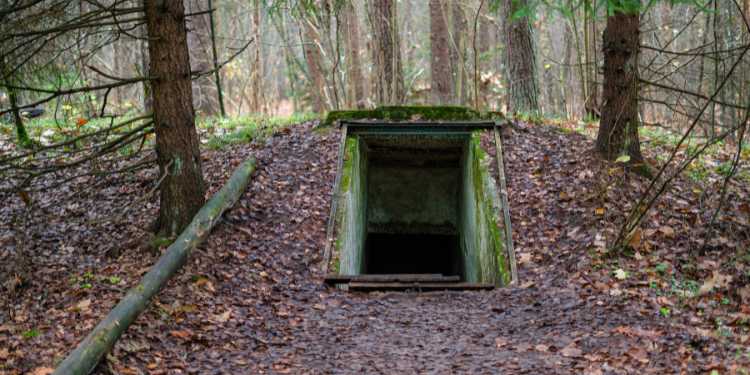 Source: https://www.askaprepper.com/
Source: https://www.askaprepper.com/
Bunkers, as we know them today, came into wide use during World War I, though underground fortifications date back much further.
During the Cold War, they proliferated in the civilian world, with nuclear bunkers being built under civic buildings and suburban backyards.
One of the crown jewels of prepping is building a fortified shelter for your family, and there are many variables to consider when building your underground refuge. I lived in a bunker for three weeks during a modern conflict, and this is how it went.
The Bunker
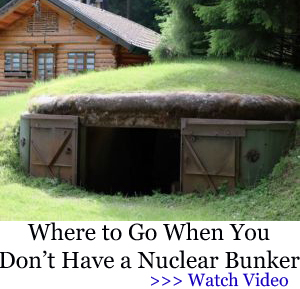 The bunker I lived in was not built initially as a one. It was the basement of a small supermarket with a concrete roof and walls. It had several floors above it to provide additional protection, bathrooms, and a food stockpile.
The bunker I lived in was not built initially as a one. It was the basement of a small supermarket with a concrete roof and walls. It had several floors above it to provide additional protection, bathrooms, and a food stockpile.
When it was evacuated of civilians and occupied by the military, an armory was built along with a communications center and additional food and water stockpiling. However, even if you have a water stockpile, you should learn THIS.
A large sleeping area was built out of plastic pallets and cardboard boxes. There was a dining area and a significant stockpiling of military-related goods. At least 75 soldiers could fit comfortably within the bunker, and operations were carried out with this bunker as the main kick-off point.
Comfortability in war is having a relatively safe place to sleep, food and water, and being able to take off your armor for a bit. The bunker was far from being luxurious.
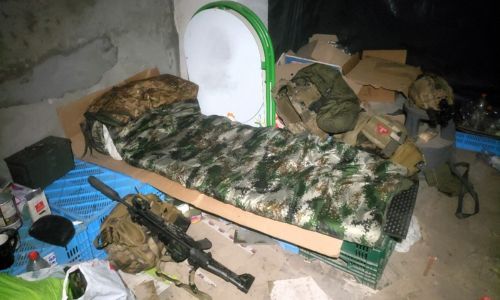
Unreliable Electricity
I felt safe in the bunker, but it was certainly not an attractive environment. Electricity and running water were already cut off in the city, so there were only the lights we could power with our generator. All fuel for the generator had to be carried in through enemy artillery fire.
Sometimes, the generators would go out, and we would be left with burning trench candles for lighting. These candles were also the only source of warmth beyond whatever clothes we were wearing.
Trench candles are often made in tin cans with tightly rolled cardboard that is soaked in flammable wax. They can burn for about an hour but give off a thick black smoke that is hard to breathe. With multiple candles burning, the air quality was very poor.
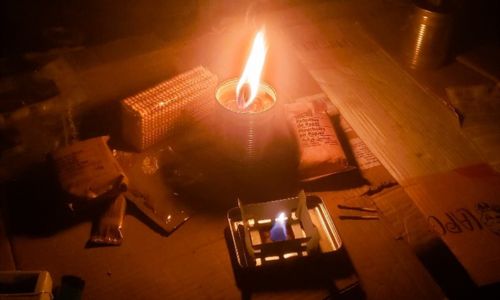
Sanitation Problems
Without running water, the toilets quickly became overloaded with human waste. Luckily, they were on the floor above and adjacent to the bunker, isolated from the living areas. Being on the floor above, they were also more exposed to enemy artillery fire, and we had to be quick about doing our business there.
Eventually, the smell and filth became nearly overwhelming, and soldiers began relieving themselves in empty food bags and then throwing them into the bathrooms, slowly burying the toilets. This may sound like bad housekeeping, and it is, but it was also a necessity.
There was no chance to go outside and relieve ourselves without being under severe threat of death or injury from the artillery. The only supplies coming in or out were the ones most crucial to military operations: food, water, fuel, ammo, medical supplies, and more soldiers.
Mounting Trash
Trash became an issue as well. Entire rooms became trash heaps over the weeks as empty ammo cans, food wrappers, and general waste piled up.
Trash could be thrown outside, but it would make the bunker much more visible to the enemy. If they could see the rate at which trash was piling up, they would know how many soldiers were there, and it would become a greater target for destruction.
Related: 30 Smart Ways to Reuse Things That You Usually Throw Away
Even with the trash concealed inside, the bunker was shelled frequently as supply trucks pulled up and armored vehicles left with soldiers going up to the contact line or being rotated to the rear. Supply trucks had only minutes to drop the supplies and drive off again or incoming shells would hit them. There was no time to load up trash for their return trip.
Compromised Roof and Infiltration of Water
The incoming artillery gradually destroyed the floors above the bunker, with one 152mm shell even crashing through the roof of the generator room. Luckily, it did not explode, but the room was now compromised, and the generators had to be closer to the living areas, where the inhabitants breathed more of the exhaust fumes.
The constant shelling also opened cracks in the ceiling, and rainwater began to drip into the bunker. The water would pool on the ground under boxes and in the lower sections of the bunker. Mold quickly grew. The trash became wet and smelled even worse than before.
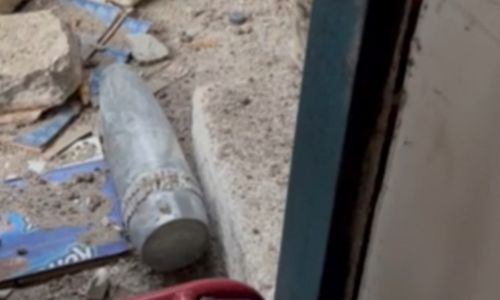
The growing mold, human waste, cold and damp environment, trash heaps, trench candle smoke, and generator exhaust all combined to create very poor air quality. I developed a lung infection, as did many others. It was difficult to breathe.
Having the right medications, especially antibiotics, is crucial to deal with infections. Since antibiotics are typically not available over the counter, here is an ingenious way to stockpile antibiotics without a prescription, before it’s too late.
All of the ventilation ducts were without electricity, so it wasn’t getting any better within our abilities, only by the artillery breaching more and more passages for airflow. The only good air was outside with the artillery. The myriad of threats to health inside the bunker were still less severe than being outside. Overall, I was happier to be in the bunker than outside.
Advice for Your Home Bunker
Water and Sewage Planning
My time in this bunker was purely a military endeavor, but many details still apply to preppers and their home bunkers. Whether you are building yours to survive nuclear war or just as a safe haven from marauding criminals, apply the lessons learned in war to your bunker. Plan for a lack of running water and electricity by having systems that do not rely on them.
⇒ This Homemade Device Can Power Up Your Entire House 7 Days in a Row
You should have a manual water pump for a well or a sufficient stockpile of water jugs. Your sewage system must be able to remove solid and liquid waste, whether it is a composting process or complete removal from the premises. Have a manual backup plan for sewage treatment or removal.
Ensure Clean Air
Have ample ventilation, both electric and manual. Air quality can get very bad very quickly, and you need a method of keeping your air clean. Electric systems are more efficient and robust, but do not rely on them solely.
Generator exhaust should be piped away from living quarters, and there should be redundancy in case the room or exhaust path becomes compromised.
Mold is an extremely determined organism and will grow wherever the conditions are remotely suitable. An air dehumidifier will help keep your bunker from becoming a home to mold and also provide you with extra water.
Prevent Leaks
Have multi-layered overhead protection that can withstand explosions and rainwater. A single layer of concrete is not enough to keep the water out. Waterproofing is necessary, and alternating layers of waterproofing and physical shielding from explosions or digging will keep your bunker in good condition.
In the event of water leakage within the bunker, have a means to get it out. Whether you mop it up or have a bilge system, removing standing water will greatly improve your ability to maintain healthy living conditions.
Good Housekeeping
You will surely generate trash while occupying your bunker. A holistic approach to your stockpile planning may make your trash reusable in some way, but some trash is just useless, and you need to have a way to deal with it. Simply throwing it outside is the easiest solution, but it also highlights the presence of someone living there and makes you a target. Going outside will also expose you to whatever threat is out there.
As you can see, preparing for every aspect of bunker life is a complicated and resource-intensive task. It can be cost-prohibitive to have built-in solutions for each of the difficulties associated with bunker life, but you can at least begin by having a plan for dealing with each of these hardships.
Building, furnishing, and stockpiling a bunker is only half the battle. You will have to live there, maintain the bunker, and defend it from human and natural threats. It is quite the endeavor to have a successful and livable bunker, but when SHTF, you will be very happy to have done the proper planning and preparations.
What tips do you have for making bunker life more livable over the long term, especially in hostile environments? Let us know in the comments!
Anyone can join.
Anyone can contribute.
Anyone can become informed about their world.
"United We Stand" Click Here To Create Your Personal Citizen Journalist Account Today, Be Sure To Invite Your Friends.
Lion’s Mane Mushroom
Mushrooms are having a moment. One fabulous fungus in particular, lion’s mane, may help improve memory, depression and anxiety symptoms. They are also an excellent source of nutrients that show promise as a therapy for dementia, and other neurodegenerative diseases. If you’re living with anxiety or depression, you may be curious about all the therapy options out there — including the natural ones.Our Lion’s Mane WHOLE MIND Nootropic Blend has been formulated to utilize the potency of Lion’s mane but also include the benefits of four other Highly Beneficial Mushrooms. Synergistically, they work together to Build your health through improving cognitive function and immunity regardless of your age. Our Nootropic not only improves your Cognitive Function and Activates your Immune System, But it benefits growth of Essential Gut Flora, further enhancing your Vitality.
Our Formula includes:
Lion’s Mane Mushrooms which Increase Brain Power through nerve growth, lessen anxiety, reduce depression, and improve concentration. Its an excellent adaptogen, promotes sleep and improves immunity.
Shiitake Mushrooms which Fight cancer cells and infectious disease, boost the immune system, promotes brain function, and serves as a source of B vitamins.
Maitake Mushrooms which regulate blood sugar levels of diabetics, reduce hypertension and boosts the immune system.
Reishi Mushrooms which Fight inflammation, liver disease, fatigue, tumor growth and cancer. They Improve skin disorders and soothes digestive problems, stomach ulcers and leaky gut syndrome.
Chaga Mushrooms which have anti-aging effects, boost immune function, improve stamina and athletic performance, even act as a natural aphrodisiac, fighting diabetes and improving liver function.
Try Our Lion’s Mane WHOLE MIND Nootropic Blend 60 Capsules. Today Be 100% Satisfied Or Receive A Full Money Back Guarantee Order Yours Today By Following This Link.






